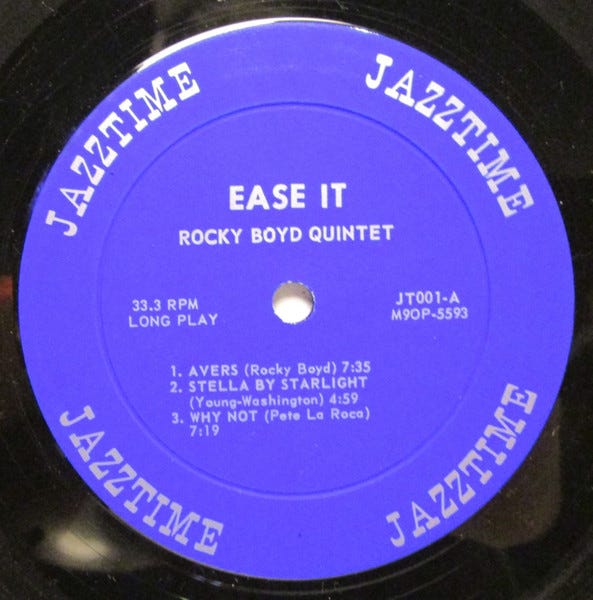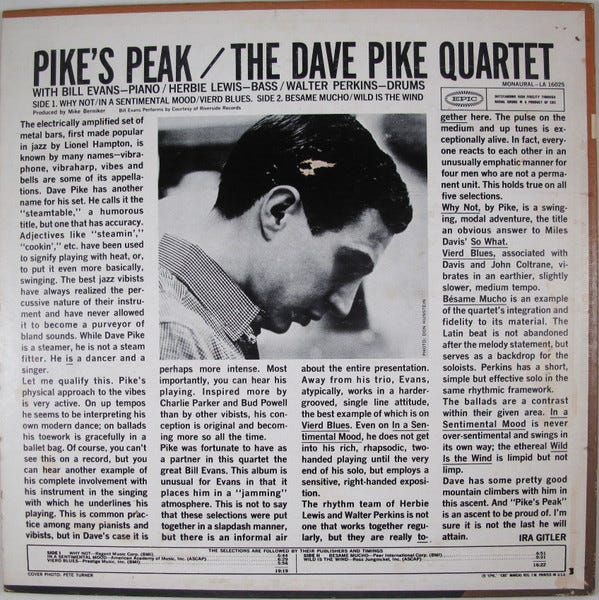Coltrane: The Origin of "Impressions," Part 4 (Last)—& Bonus Tracks for Paying Subscribers
Bonus Tracks for Paying Subscribers
(Paying Subscribers, at the bottom of this article you will find your latest bonus!)
In the preceding posts, I explored in detail how Coltrane composed and titled “Impressions.” The “official” version of the piece, recorded at the Village Vanguard in November 1961, was finally released as the title track of an album in July 1963. It’s funny to read the text of the short “review”—really, these “reviews” were promotional statements— in the music industry magazine Cash Box, because it uses a lot of words to say pretty much nothing. Here it is:
It reads:
John Coltrane, a charter member of the new wave school of jazz artists, directs his talents on the tenor and soprano saxophones toward four modern musical areas. The instrumentalist devotes both sides to four tracks of self expression and musical improvisation. The discerning jazzophile will find these personal statements imaginative and tasteful.
The “four areas” simply refers to the fact that the album had four tracks, two on each side of the LP. My guess is that the person who wrote this was not a Coltrane fan, but had to come up with something!
But why did it take so long for the Impulse record company to release it? Well, Impulse and producer Bob Thiele were concerned about Coltrane’s press. He had received some great reviews in the past, but in the fall of 1961, at the very time that he was being recorded at the Vanguard, some critics were expressing hostility to his performances with Eric Dolphy. And when Live at the Village Vanguard was released in February 1962, some of the reactions were extremely harsh and negative, especially to the long blues “Chasin’ the Trane.” This made Impulse, and Thiele, very reluctant to follow it with another “live” Vanguard recording!
So Thiele, with John’s cooperation, was on a campaign to establish Coltrane as an accessible artist, and—let’s be honest—to make some money! The resulting albums were musically deep, but also easy to understand. Duke Ellington and John Coltrane was released in February 1963, Ballads was released in March, and the album with Johnny Hartman was released in July, along with Impressions. That last album may seem contrary to Thiele’s goal, but by then he felt that he needed to pair the “commercial” albums with something for the hardcore jazz audience. (In a future post, I will provide a more detailed report about Coltrane’s relationship with Thiele and Impulse.)
During all this time, Coltrane was performing “Impressions” just about every night, and musicians started to notice it. In fact, “Impressions” was recorded on two albums by non-Coltrane bands, before Coltrane’s “Impressions” came out! In both cases they simply played the A theme up a half-step for the melody of the bridge, as Coltrane was doing at first, in 1960. (See Part 2.) Both times, the tune was titled “Why Not?” — a joke on “So What?,” which is what Coltrane called it at first.
The first recording of “Why Not?” was led by saxophonist Rocky Boyd, from his album Ease It. It was recorded with trumpeter Kenny Dorham, Walter Bishop Jr. on piano, Ron Carter on bass, and Pete La Roca on drums in February of 1961, and released later that year. John Erskine “Rocky” Boyd was born on June 27, 1936 in Boston, and died there on February 25, 1986 (according to a document that I found on Ancestry.com). He worked with drummers Sunny Murray—who considered Boyd something of a mentor—and Max Roach, and in the Miles Davis autobiography it says he briefly filled in after Hank Mobley left. But this album is his only recording. Ron Carter told Ethan Iverson that he remembered this being a good session. Here’s the theme of “Why Not?”—notice that Bishop plays Gould’s background riff on the piano:
A later release of the same album under Dorham’s name, retitled West 42nd Street, included an extra take at a slightly slower tempo.
(Paying subscribers, scroll down to hear both takes, complete, with my thanks!)
On Boyd’s album, “Why Not?” is listed as a LaRoca composition:
I knew Peter “La Roca” Sims (1938–2012) a little. He was a marvelous person as well as a great musician. I met him when I was 15, and a month or so later we went to the Vanguard together. So around 1995, I phoned and asked him about this session. He was a lawyer then, but still performed on occasion. He told me that of course he knew the piece, because he’d played it as a member of Coltrane’s quartet in the summer of 1960, before Elvin Jones took his place that fall. La Roca also said he knew the theme wasn’t Coltrane’s, and that it was by Gould. It was he who had brought the tune to the Boyd session.
“I might have been in on the thought process, underlying naming [of ‘Why Not?’] and all the rest of that,” La Roca told me. But he also acknowledged that he shouldn’t have been listed as composer, and he suggested that credit might have been Boyd’s idea.
There was another recording a year later: The jazz photographer John Rogers reminded me that the terrific vibraphonist Dave Pike (1938-2015) recorded this theme, with Bill Evans on piano, in February 1962 (some releases say November 1961, but that appears to be incorrect). But this time it’s credited to Pike! Why?
I had the chance to ask Pike that question, about three years before he died. It turns out that La Roca was his source for this tune as well! By email, Pike explained that he was performing with La Roca at that time, “and he played it for me. I thought that either he wrote it, or it was just what we used to call a ‘riff’ behind somebody's solo.” In fact, on Pike’s version, it works exactly that way: Bill Evans solos on piano while the band plays the theme behind him. Let’s listen:
(Paying subscribers, scroll down to hear the complete track—it’s a nice one!)
As for the credit to Pike, I have mentioned before that whenever there was no composer already on file for a piece, record companies preferred to give their own artist the composer credit. (This will be the subject of a detailed post later on.) If Pike said something like “Oh, that’s just a riff that someone showed me” or “it’s a riff that’s going around,” the producer would have usually said “In that case, let’s credit it to you.”
Since both Boyd and Pike got the melody from Pete La Roca, that explains why they used the theme up a half-step for the bridge: When La Roca was in the quartet, that’s what John was using for the bridge. Conversely, this also provides more evidence that that is how John played it at first.
Boston-based saxophonist and composer Allan Chase remembered on Facebook that “Once I was in the Vanguard and Morton Gould was in the audience and recognized from the stage.” (That is, the bandleader gave him some “recognition” by announcing that Gould was present.) “They weren’t playing his tune, though.” Even though they weren’t playing “Impressions” at that moment, it’s clear that Gould was interested in the jazz scene, and he must have heard some of the jazz versions of his “Pavanne” themes. And the fact that all these people made use of his themes without anyone — Gould included — expressing any disapproval shows how differently people treated “intellectual property” back then. Ideas flowed from one person to another. As Coltrane said in his interview with the late Frank Kofsky: “It's a big reservoir that we all dip out of.”
All the best,
Lewis
P.S. Some musicians have asked me to discuss the way Coltrane’s quartet played “Impressions.” I’ve decided to make that into a separate post.
P.P.S. Paying subscribers, keep scrolling for your gifts below!
Keep reading with a 7-day free trial
Subscribe to Playback with Lewis Porter! to keep reading this post and get 7 days of free access to the full post archives.





